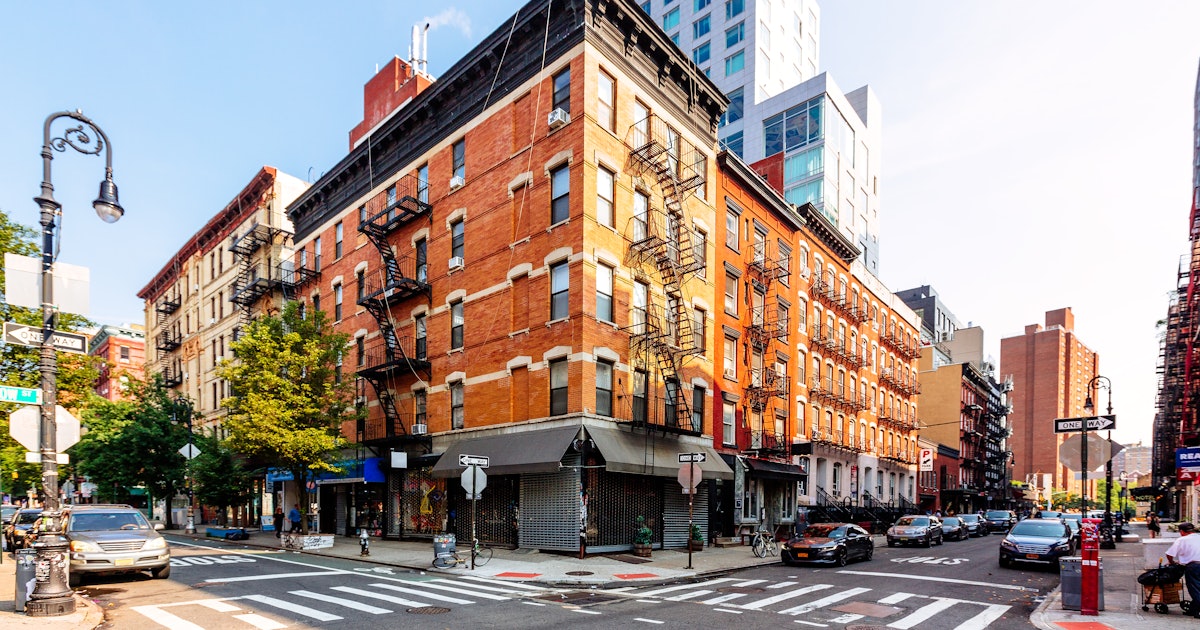
For 15 years, the writer and activist Jeremiah Moss has fought to restore a city he has never known. His long-running blog, Jeremiah’s Vanishing New York, is a painstaking document of Lower Manhattan’s osmotic turnover, cataloging real estate grabs and the ravages of neoliberal policy through elegiac dispatches from shuttered storefronts. As diners, dancehalls, and hardware stores close around him, Moss grieves the loss of landmarks and community spaces, steeling himself for their upmarket successors. Beholding the ceaseless course of retail gentrification, he yearns for the rough-and-tumble city of the 1970s, propounding a Shangri-La of strivers, immigrants, artisans, and agitators.
“One of the great tragedies of my life was that I had the misfortune to arrive in New York City at the beginning of the end,” opens his 2017 book Vanishing New York: How a Great City Lost Its Soul. A trans man steeped in the wistful writings of Joseph Mitchell and Frank O’Hara, Moss moved to New York from Massachusetts in the early ‘90s, planning to write poetry. Within months of Moss’s arrival, Rudy Giuliani took Gracie Mansion, pledging to stamp out petty crime and reestablish Manhattan as a global capital. Giuliani’s favoritism toward upper-class homeowners was codified in the N.Y.P.D.’s quality-of-life initiatives, heralding an open season on the city’s visible poor.
“Save NYC” is a rallying cry in Moss’s advocacy work, a slogan that might as easily embody the tough-on-crime revanchism of Giuliani’s right-wing supporters. Like Giuliani, Moss is obsessed with the question of who deserves New York. The answer, in his writing, is at once obvious and equivocal. Queer and Black folks, of course: the rest of the country is hostile to them, and New York offers a sanctuary of sorts. From there it gets murky. Despite its rigorous analysis of housing policy, Vanishing New York is primarily an aesthetic doctrine, asserting municipal decorum as a way of life. “It’s a tuna sandwich at Eisenberg’s, an egg cream at Ray’s Candy,” Moss writes of the city’s noble essence. “It’s shoeshines, dive bars, and riding the subway all the way to Coney Island for a corn dog.”
Moss is obsessed with the question of who deserves New York.
Moss’s new book, Feral City: On Finding Liberation in Lockdown New York, further delineates the authentic and the unworthy. When the pandemic hits, Moss’s antagonists — brunch-obsessed Villagers, smartphone-tethered millennials, Chipotle-scarfing Midwesterners — vacate the city en masse, abandoning it to long-suffering natives and righteous weirdos. After loafing around his apartment for a few days, Moss ventures outside and delights in the scenery. “The New People are really gone, their absence like an atmosphere, the sky clear after a storm,” he exults. “The park is sparsely populated with ordinary folks, working-class locals, and diehard East Village types.” He and his comrades, whom he dubs the Leftovers, “feel more connected, more human, less alone.” His dreamscape has finally come to fruition — all it took was an airborne pathogen.
Traversing the deserted island, he communes with a fellow Leftover on Avenue A, a woman who gloats, “Woo-hoo! We’re still alive!” He’s drawn to the Occupy City Hall demonstration, and soon begins riding his bike alongside Black Lives Matter marches. Invigorated with purpose, Moss beholds the revolutionary spirit gripping the city. “What if we got together in the expansive potential of collective queerness?” he wonders. In conflating the Floyd marches with queer liberation, Moss, who is white, attempts to cover his tracks, insisting that by “queer” he means the marginalized, the dispossessed, the non-normative. Still, it’s a convenient abstraction that allows him to revel in tragedy — the murder of George Floyd occasions the redemption of Jeremiah Moss.
“I sometimes worry about romanticizing the gutter from the safe distance of my relative privilege,” Moss confesses in a chapter devoted to the concept of “queer negativity.” Queer negativity, he writes, manifests in “nostalgia for the mud,” a taste for the macabre, the decaying, the red-light district. Naturally, this sensibility is aroused “in this summer of plague, when so much of Manhattan looks like a pre-gentrified ruin, covered in graffiti, abandoned behind plywood.” The vibes may be immaculate, but there’s little hand-wringing regarding cause and effect. His cherished ambiance is a function of public health collapse; the plywood guards assets against fallout from a police murder. Surely there are degrees of queer negativity — might one enjoy a divey happy hour without toasting the deaths of thousands?
Readers unfamiliar with Moss’s polemics may find the triumph of Feral City jarring, but its surly sentimentality can be traced back to a scene in Vanishing New York. Visiting the San Gennaro Festival, a street fair in the historic Little Italy district, he’s furious to learn that residents have contested the festival’s parade license, complaining of noise and smoke in their homes. In Feral City, Moss — who’s lived for decades in a rent-controlled East Village apartment — bemoans the ruckus of St. Mark’s Place, where fratty twenty-somethings make merry into the night. The drunkenness and decibel levels are comparable; they could be the same people, for all we know. But to Moss, the hierarchy is clear: San Gennaro, a white-ethnic homage in a quaint neighborhood, pays obeisance to assimilated immigrants, whereas the Braydens vaping outside Bua only celebrate themselves.
This contradiction plagues both books. New York, in Moss’s estimation, should be a haven for queers and iconoclasts, freaks and misfits, punks and radicals. Yet New Yorkers must also conform to civic culture, support longstanding institutions, and revere their predecessors. For all his expertise on upzoning and eminent domain, Moss eyes gentrification as a matter of spiritual decline. “We can’t just blame ‘market forces’ and leave it at that,” he writes in Vanishing New York. “We have to look at people, their deepest fears and desires, and how they’ve helped change the character of the city.” If developers and politicians sold out the city, yuppies keep buying it.
Feral City and Vanishing New York inadvertently convey the hollowness of New York’s urbanism debates. The squabbling factions — gentrifiers versus holdouts, YIMBYs versus NIMBYs — are often discussed in terms of a human rights clash, when really they only disagree on how the city should be sold. Both sides agree New York is a finite good, that certain groups are more entitled than others. The choice, presented as a binary, is between Michael Bloomberg’s sanitized corporate haven, and a romanticized 1970s metro populated by descendents of immigrants who lucked into cheap housing. Should city life be subject to free-market forces, or made available on a first-come-first-served basis?
The latter camp has accrued fresh cachet, if only in response to the Bloomberg period’s aesthetic drudgery. Under Mayor Bloomberg’s brutally effective “50 by 15” plan, a tax-funded initiative launched in 2006 to attract 50 million annual tourists, New York became a city — like Las Vegas or Orlando — catering to visitors at the expense of taxpaying residents. Commercial landlords evicted small businesses in favor of chain retailers, whose credit ratings inflated property values; tax abatements were handed to franchise restaurants and hospitality groups like lollipops in a barber shop. NYC & Company — a private agency whose board includes executives of Disney, Delta, Mastercard, and, uh, Bloomberg LP — received an eight-figure contract to curate a “unified brand identity” while promoting Manhattan landmarks in overseas markets. But with rent soaring and low-income groups driven from their ancestral homes, a new branding problem presented itself. Bloomberg had spent billions transforming New York into a swath of glittering Marriotts, Starbucks, and Wells Fargo branches, a frictionless metropolis that looked and felt like any other. Why visit New York if it’s the same as Dubai and Hong Kong?
Soon enough, the city’s image-makers shifted their message to one of New York exceptionalism. Consider New York Nico, a putative filmmaker contracted by the Metropolitan Transportation Authority to imbue transit announcements with “a dose of authentic New York swagger.” His Instagram traffics in cloying caricatures, proffering a dreamland of pizza, bagels, parades, and flea markets. His subjects — shopkeeps, street performers, jawing Nuyoricans and gesticulating Italians — are modern anomalies, miraculous survivors of the city’s ferocious churn. It’s a distillation of what the Times’ Willy Staley calls “bodega fetishism”: the idea that working-class signifiers, by no means unique to New York, are in fact extraordinary genes in the city’s DNA. Remember how out-of-towners used to hug Elmo in Times Square? Now, they can gawk at the last Sicilians on Graham Avenue.
The schmaltz is grating because of how demonstrably false it is. You don’t need to spend time in New York to know it is a place inhospitable to artists, ethnics, and tradesmen, the very people objectified by this mythology. But as the city grows more mundane and expensive, these disappearing touchstones —pool halls, accents, dice games, slick haircuts — have become precious commodities. Those who buy into the lore of New York crave evidence that their city is distinct from Boston and Toronto and Missoula. Meanwhile, the idealization of a vibrant, pre-Bloomberg utopia continues to lure upwardly mobile transplants, who in turn displace the people we’re told make the city special.
Like Nico’s rosy propaganda, Moss’s glamorization of beleaguered businesses reads like a travel brochure. “Along with the people, we lost too many of our Polish and Ukrainian coffee shops, our cobbler shops and laundromats, our theaters and performance spaces, record stores and bookstores,” he laments in Vanishing New York. It’s not an ethical argument, or even a civil liberties gripe: he mourns bygone grocers and studios as ardently as he does chop-shops and Mobil stations. Moss believes not only that small businesses are the wellspring of civic society, but that it’s our responsibility — as civilians and consumers — to ensure their ongoing prosperity. New York was a great city because of its vivacious business community, its downfall spelled by multinational corporations and politicians who greased the wheels. It isn’t that gentrifiers encroach upon our rights, not really. It’s that they have shitty taste.
It isn’t that gentrifiers encroach upon our rights … It’s that they have shitty taste.
From there it’s no huge leap to the irascible politics of Feral City, a book that cheers along a pandemic. For all his writing on New York’s demise, Moss rarely approaches the city as a collective of people. He doesn’t evoke a place where folks live, grow, learn, work, and fall in love. Instead, it’s a consumer’s prospectus: businesses that merit protection, and others that don’t belong. When Moss implores us to “Save NYC,” it goes unsaid who we’re saving it for. In lieu of a cause, Feral City advocates for an experience. Early in the book, Moss purchases a “New York Fuckin’ City” t-shirt from a vendor on Canal Street. Over the summer of 2020, he adopts it as a de facto uniform, wearing it proudly to the BLM and Stonewall marches; he becomes, to his delight, the “New York Fuckin’ City” guy. He’s not fighting for a more equitable city, just one that feels more like a Scorsese film.
“How attached are you to New York?” Moss taunts in Feral City. For him, adherence through thick and thin is a matter of pride, a gesture of loyalty. But my answer, like most folks I know, is more than I’d like to be. I wound up here as a consequence of 20th-century migration; I’ve stayed due to a comically siloed labor market, proximity to family, and, yes, cultural and political affinity. I didn’t choose New York, nor did I reject it. Should I have pride in this place where the median rent is $4,000, where school funds are diverted for more police, where you can’t even go out drinking without risking a debilitating infection — all because I’m misty about some Ellis Island narrative? This shit sucks, and it’s better than the plausible alternatives.
To choose a home, and to love it in spite of its shortcomings, is the world-historical privilege of a chosen few. Moss’s bones-deep attachment to New York City is enviable, and, in its way, extraordinary. But his compartmentalization — his euphoria at the return of grit and graffiti, at the expense of actual living, breathing humans — curdles into unbridled misanthropy. In the devastation of 2020, Moss enjoyed a brief reversal of New York’s yawning exclusivity, what felt like karmic retribution for middle-class erasure. In exchange, thousands of New Yorkers saw their lives and families upended, unable to insulate themselves from institutional failure. It was cool watching cops and billionaires squirm for, like, five minutes. Now there are more of them, and a lot fewer of us.
Pete Tosiello still lives in New York.
Source: gawker.com





